Nikhil Naciketas Sureshkumar's Notebook
Week 01
August 23, 2011 (1 hour):
Met as a team after class to discuss preliminary project proposal.
August 25, 2011 (2 hours):
Met as a team after class to finish writing preliminary project proposal.
WEEK 01 SUMMARY
Accomplishments: Submitted preliminary project proposal.
Weekly Work Total: 3 hours
Project Work Total: 3 hours
Week 02
August 30, 2011 (2 hours):
Met as a team to formulate PSSC for presentation in class on September 7. It was decided that our PSSCs needed to be modularized so that everything did not depend on the display system. Consequently, we decided to add a data logger that would independently store the telemetry data which could later used for a google maps app, that would plot the logged data with respect to time. Also, the team discussed who should research what sensors. I was assigned temperature sensors.
September 1, 2011 (3 hours):
Met as a team to finish the final project proposal. There was a discussion of available motherboards that would handle the VGA output and data processing. ARM boards, Intel Atom boards, and the TI beagle board were considered. It was also brought up that no one had researched microcontrollers, so that was remedied.
WEEK 02 SUMMARY
Accomplishments: PSSC and project proposal finalized.
Weekly Work Total: 5 hours
Project Work Total: 8 hours
Week 03
September 6, 2011 (4 hours):
The team met and worked on the PCB tutorial homework.
September 7, 2011 (1 hours):
I consulted with a previous 477 student who used a temperature sensor and found that the one he used to be suitable for our needs. TMP35.
September 8th, 2011 (3 hours):
I got my Homework 2 checked off. There was discussion as to the motherboards and it was decided we would use an Intel Atom motherboard since it would be free. Aditya did some research on an optical system that would enhance our project's display. The goal of the system is to project the image on the visor while making it look like it is a few feet ahead of the helmet for better experience. An image that better describes the system needed follows:
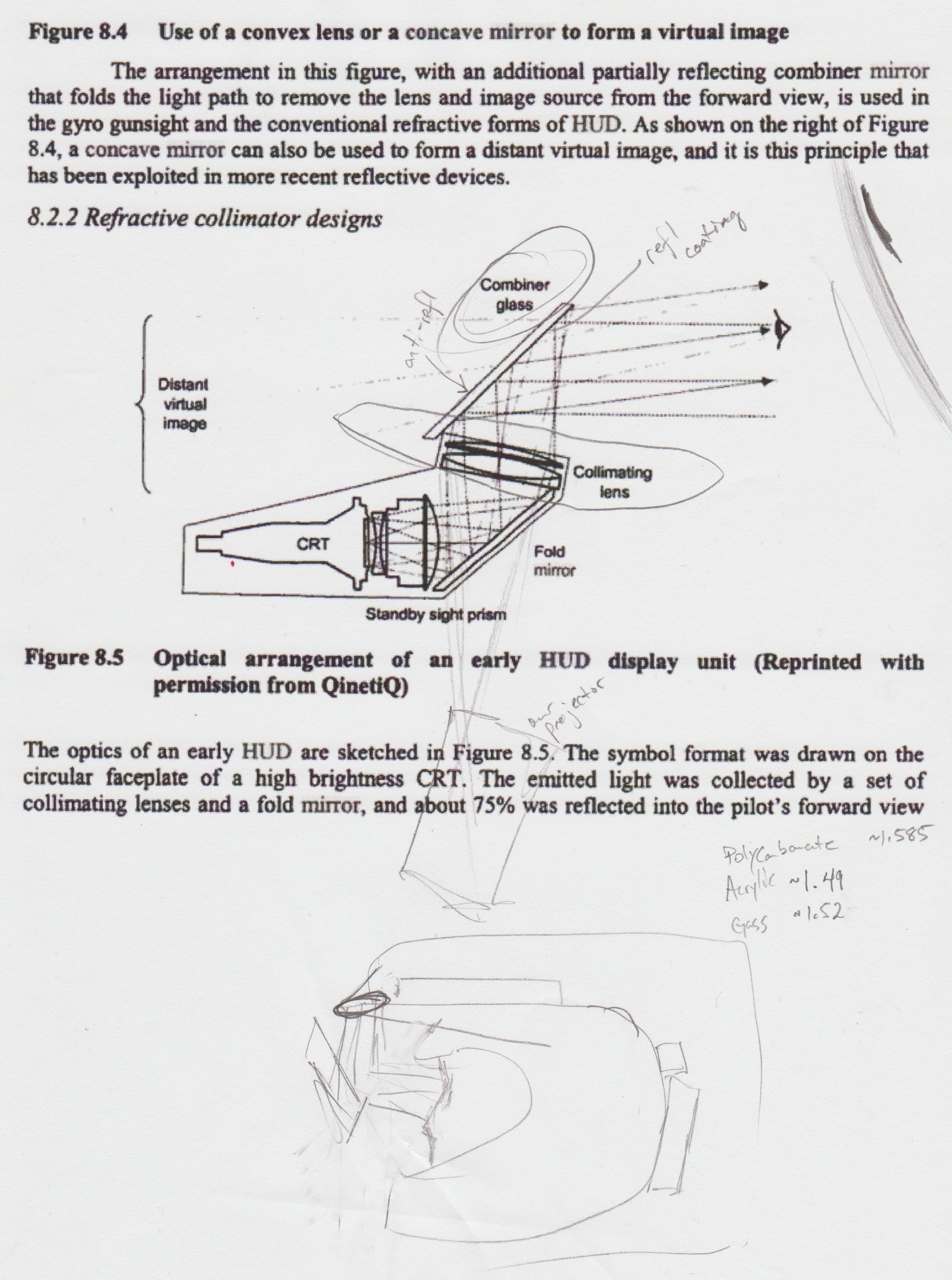 We decided to talk to an optics professor on this.
We decided to talk to an optics professor on this.
WEEK 03 SUMMARY
Accomplishments: I found a temperature sensor we can use.We decided on an Intel Atom motherboard8(FREE). Aditya found a prelimary optical system which needs to be validated by an expert.
Weekly Work Total: 8 hours
Project Work Total: 16 hours
Week 04
September 13th, 2011 (1 hour):
The Lexan and reflective window tint came in and I worked with Aditya to test it on the fiberglass. The projector managed to get a decent image on the tinted glass, but it looks we still need that combiner glass for better reflection.
September 15th, 2011 (2 hours):
I edited the report that Aditya made.
WEEK 04 SUMMARY
Accomplishments: I did not do much.
Weekly Work Total: 3 hours
Project Work Total: 19 hours
Week 05
September 20, 2011 (3 hours):
Blaine and Aditya were working on getting the GPS module to talk to the computer via UART interface. I helped them as much as I could with the debugging process. We were originally getting garbage from the serial port, but after looking through the GPS manual, it was decided that the stuff we were getting was not actually garbage but it just looked like garbage to ASCII translation on the PC side. It finally ended up working and we used Trimble GPS studio to gather relevant information. I then helped mobilizing the GPS and the laptop that we were testing on to see if it worked outside. Aditya and Blaine took it for a walk outside in the engineering fountain. The test route outside is included here:
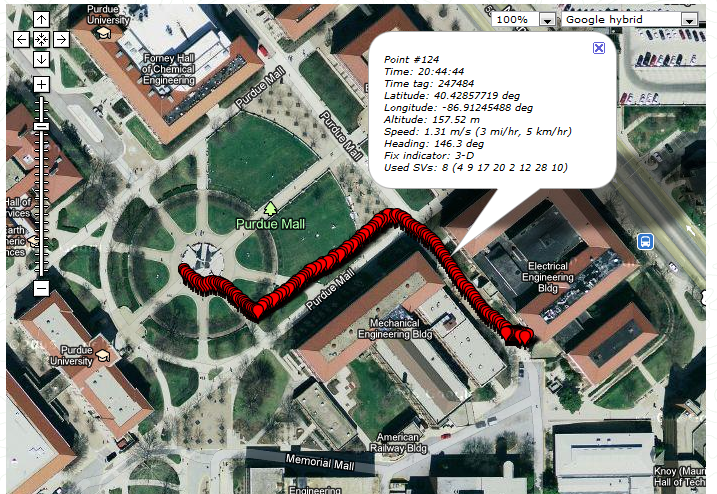
September 21, 2011 (2 hours)>:
I finished working on the creating the voltage regulator package for Marcelo's report due friday.
September 22, 2011 (5 hours)>:
I created the accelorometer breakout board package and started creating a schematic with the Aditya's microcontroller, the volatage regulator, the accelerometer, and the GPS module(whose layout was conveniently found at sparkfun).
September 23, 2011 (1 hour)>:
With some last minute touches to the schematic and layout, I sent pictures of my work to Marcelo for his report.
WEEK 05 SUMMARY
Accomplishments:Worked with Aditya and Blaine on GPS. Footprints were created for the major components of the PCB, and I made a schematic and layout of the micro, gps, accelerometer, and voltage regulator.
Weekly Work Total: 8 hours
Project Work Total: 27 hours
September 27, 2011 (6 hours):
Worked on the primary schematic that would go on the helmet. This PCB would include the microcontroller, GPS, accelerometer, temperature sensor and a DB 25 connection that would go to the backpack PCB for communication with the microcontoller. Aditya worked on the backpack PCB which is shown below.

September 28, 2011 (3 hours):
During the preliminary schematic presentation, concerns were raised over our lack of fuel guage and batter recharching circuitry. We had previously assumed that we could simply remove the battery from our unit and then charge it externally, but it would be cool if the charger was included in our design. Secondly, it was suggested that we needed a fuel guage that could monitor the battery's charge. We had never really thought about this but it seems like it is a essential component in our design we overlooked. The fuel guage is needed for the following reason: If the battery is depleted and our system is still in use, it would damage the battery. Team 4 who is also using a Li-Po battery gave us suggestions to look at for fuel guages and charging ICs. The ICs suggested by Team 4 were : the MCP73213 for the charging controller, and the DS2782 for the fuel gauge (communicates to micro via I2C).
September 29, 2011 (8 hours):
In order to accomodate the new ICs into our PCB(charging IC and fuel guage), it was decided that entire circuitry should be moved to one PCB unit in the backpack unit. This is because the fuel guage needs to talk to the micro over the I2C and we didn't want to implement this over the DB25 connection. Additionally, the fuel guage requires 3.3V power, and there is only 5V power in the backpack unit under the current configuration. I worked on updating our PCB library to accomodate the new parts while Aditya worked on Windows embedded 7 stuff for the not-yet-arrived atom board. At the end, we decided on another charging,the MCP73842.
October 2, 2011 (1 hour):
Aditya started to put together an official Bill of Materials for the team. The BOM can be found hereWill begin to try and follow Blaine's footsteps regarding documentation using a camera - expect more pictures from now o
WEEK 06 SUMMARY
Accomplishments: Finished one version of prelimary PCB schematic. Decided to overhaul it due to battery management circuitry. Started working on final PCB schematic
Weekly Work Total: 18 hours
Project Work Total: 45 hours
Week 07
October 4th, 2011 (5 hours):
It turned out that several microcontroller circuitry was incorrectly wired in the preliminary schematic. Apparently, the micro was not being powered at all. This was promptly fixed. Read the motorala app note for the TCSP presentation and made the powerpoint for it.
October 5th, 2011(4 hours):
The combiner glass arrived, and we spent some time playing with it. It is more reflective that we would have liked. It might be a little too bright on the user's eye. Worked on finishing up the schematic with the correct packages with Aditya. Some final changes to the schematic include a switch that would control whether entire PCB would powered by the battery(default) or by the external wall wart which is currently used for the charging IC. This wall wart power capability is purely for debugging and backup purposes in case the battery goes haywire.
October 6th, 2011(10 hours):
Made final changes to the PCB schematic and started trying to layout the components, while group worked on the charging circuit for the battery. The final PCB schematic before the PCB layout homework submission is shown below:
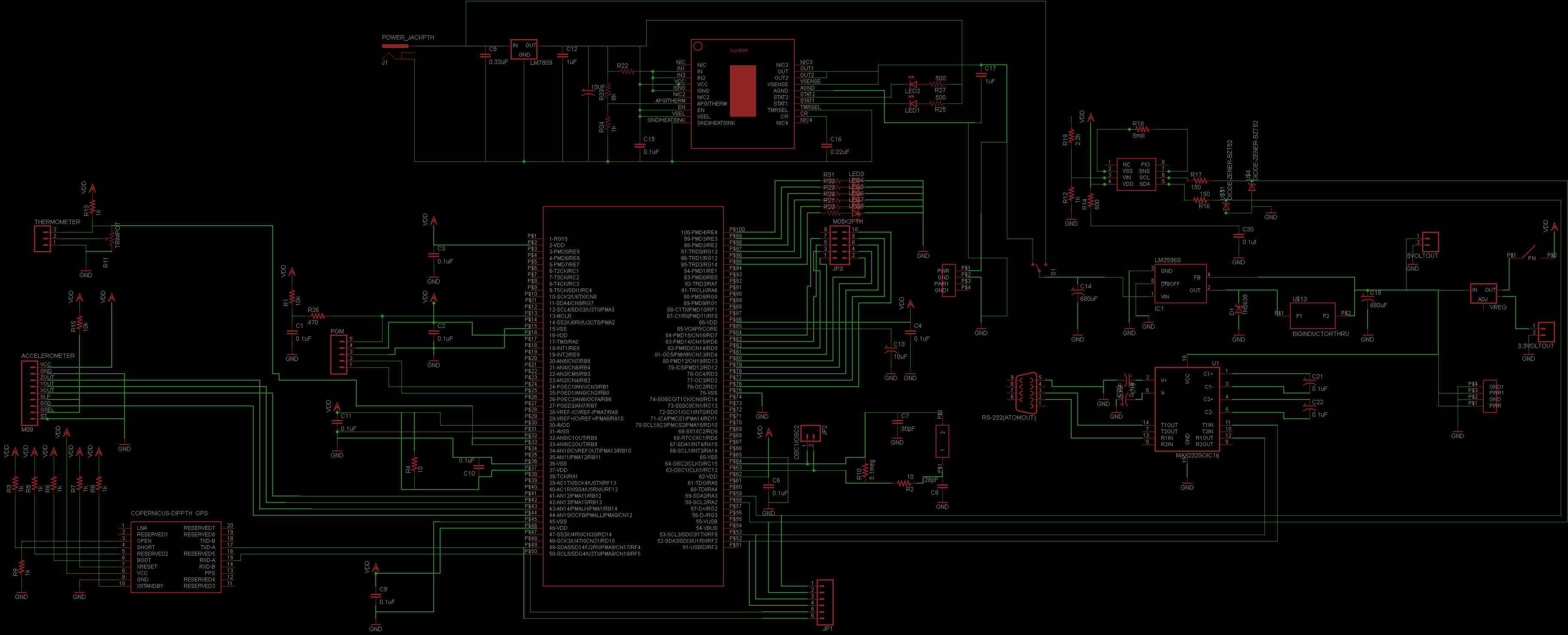 The test charging set-up is shown below.
The test charging set-up is shown below.
The write-up for the prelimary PCB considerations homework was completed. In the end, with all the last minute changes to PCB schematic, I was only able to autoroute for the PCB layout homework.
October 7th, 20111(2 hours):
Met with Paul(a PHD student in ECE optics) with Marcelo and discussed with him a way we could implement our optical system. We talked primarily about how to make it look like the image is focused past the combiner glass that we are shining on to. Finally, a solution was theorized from the idea of car side mirrors - "objects in mirror are closer than they appear". From that
phrase it was inferred that a convex mirror (or concave lens) would be able to expand the light from the
projector to make it look like it further away than it actually is. The notes from the
meeting are below:

WEEK 07 SUMMARY
Accomplishments:Finalized PCB schematic. Made an iniatial layout with autoroute(incomplete). Met with Paul to talk about optics
Weekly Work Total: 21 hours
Project Work Total: 66 hours
Week 08
October 11th, 2011 (7 hours):
Met with the team to start on the design review presentation. Aditya put in a Digi-key order with all of the parts needed for layout. Started from scratch a brand new PCB layout with no autorouting. Worked primarily on power related components first(charging IC, battery, fuel guage, regulators, etc). Man, these capacitors are huge.
October 12th, 2011 (10 hours):
Worked extensively on new PCB layout for design review. I laid out the oscillator and thermometer and worked on the microcontroller circuit. It seems that the microcontroller pads themselves are only 6 mils thick which conflict with the 8 mil recommended trace spacing. Leaving it as 8 mils for now. Aditya starting doing more cad work for the design review. The updated models can he made can be seen below. I would like to comment on the awesomeness of the new cad designs.




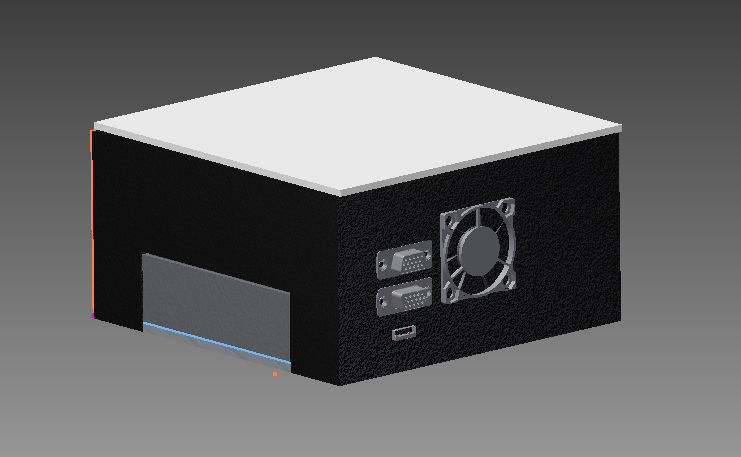

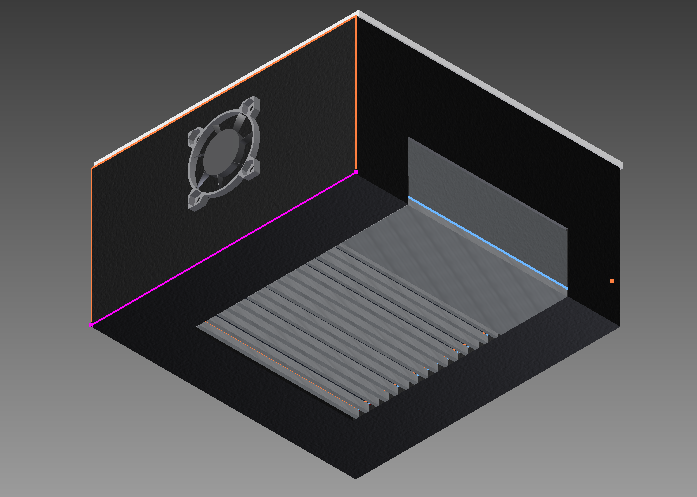
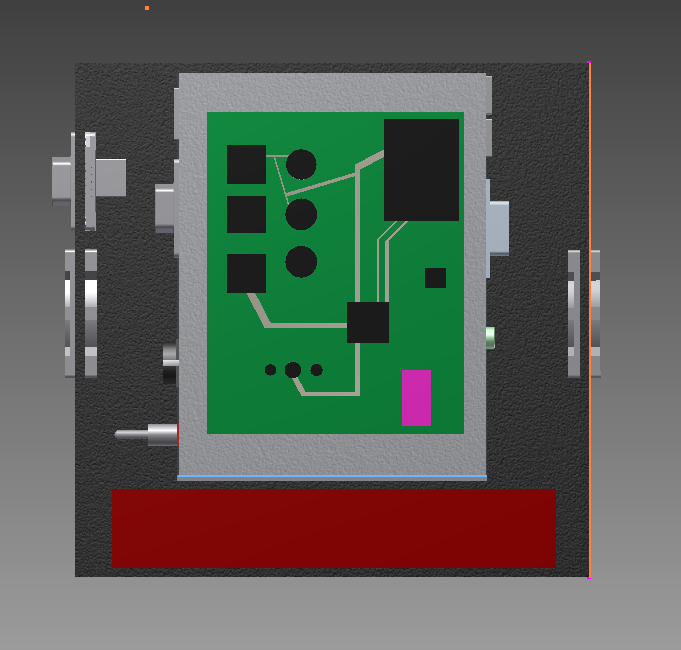
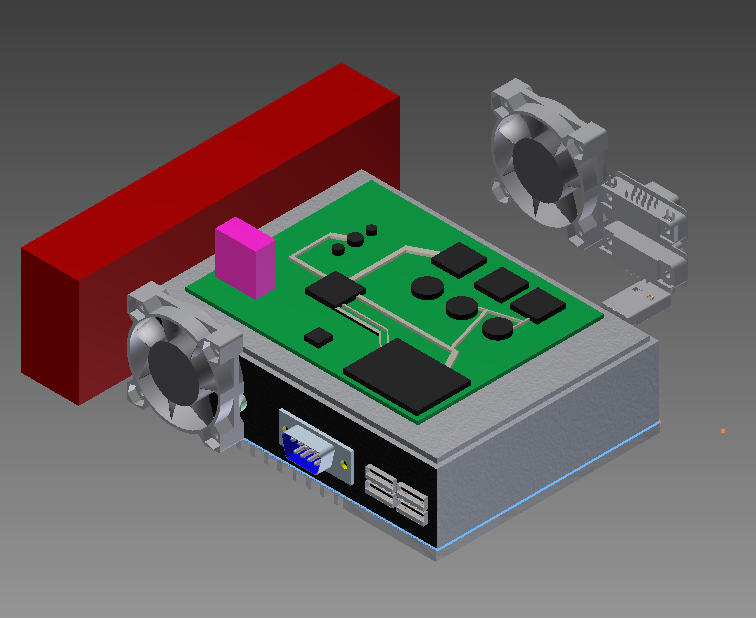
The final CAD drawing sheet can be seen here.
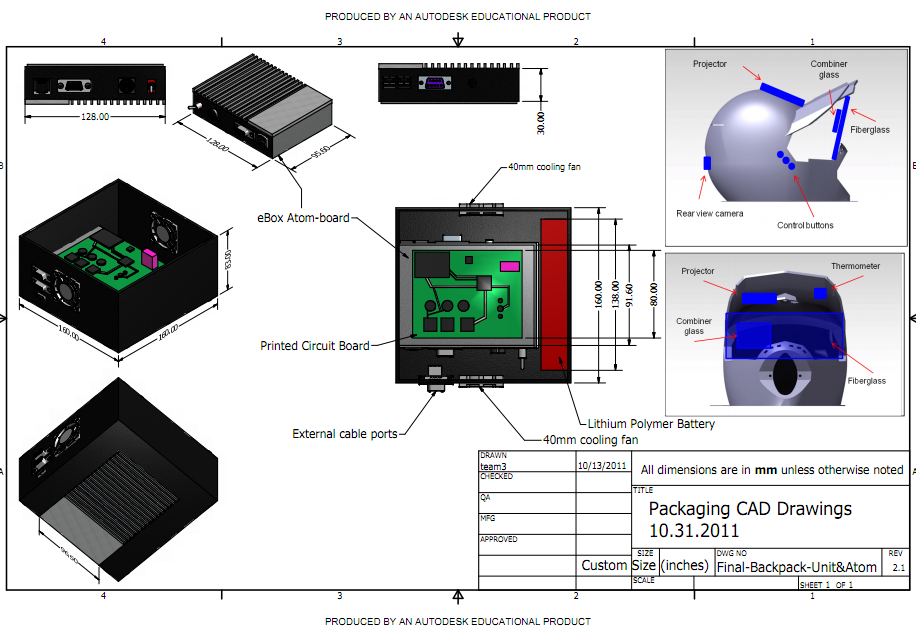
After some talk with Georges, it was decided that a ground plane is viable and preferable, so I made the entire bottom of the PCB a ground plane. By the end of the day, my custom PCB layout was routed completely.
October 13th, 2011 (2 hours):
Noticed a lot of acid traps in PCB layout, fixed that finalized layout for design review. Aditya printed out the handouts and a little extra for the course staff and peer reviewers. The documents that were supplied at the design
review are as follows: PCB, Schematic.pdf, and CAD Drawings.
October 16th, 2011 (0.5 hours):
Aditya worked on prototyping the 5 volt regulator. Pics below!
WEEK 08 SUMMARY
Accomplishments: Made custom PCB for design review. Completed design review - great success.
Weekly Work Total: 19.5 hours
Project Work Total: 85.5 hours
Week 09
October 19th, 2011 (10 hours):
Updated the PCB layout and schematic to include GPIO control of the fans. Went over DRCs several times to make sure that the layout passes. I noticed a very strange error in the layout where it would not show which traces still needed to be routed even though the schematic expicitly shows them as connected(nets too). This is cause for great concern. Pic of fans being protyped below:
While, Aditya worked on CAM procedure, I addressed the previous concern by going over the entire schematic and PCB connection by connection to make sure everything was routed. I found 2 more errors like the ones described previously. The cause of these errors are still unknown.
Last minute tweaks like adding mounting holes, tweaking the ground plane, making sure power thru holes are bigger than regular ones, and standardizing trace widths were all completed.
In other good news, the charging IC is finally protyped by the rest of the team after burning one. Pics!
October 20th, 2011 (7 hours):
Made the final PCB revisions while consulting with the Georges on various DRC exceptions I made. Everything is OK and ready for the CAM job. The CAM job was completed. The final PCB can be seen below,
along with the proof of parts.
The final Gerber files can be found
here.
WEEK 09 SUMMARY
Accomplishments:Final revision of schematic and PCB. Submitted for fabrication with gerber files attached.
Weekly Work Total: 17 hours
Project Work Total: 102.5 hours
Week 10
October 27th, 2011 (4 hours)
Tried to help Blaine debug his I2C problem with the fuel guage. Determined the correct sense resistor required for accurate readings in the CURRENT register.
WEEK 10 SUMMARY
Accomplishments: Protoyping for fuel guage partially complete.
Weekly Work Total: 4
Project Work Total:106.5hours
Week 11
November 3rd, 2011
(5 hours)
Varius problems with PCB that came in. The fuel guage and the line level translator both don't fit within their space, but it could be worked around with clever lead bending. With Blaine initiating the PCB soldering efforts, the battery
charging circuit was the first to be tested. At first glance, it looked like it was not working, but then it was realized that it was just behaving differently than the one we prototyped before. After a while, the behavior was back to normal and the charging circuit on the PCB works.(SUCCESS)
Aditya found this neat LCD screen that could be used for our display purposes since projector and the combiner glass resulted in unsatisfactory performance. After fiddling around with the helmet and screen, the results were promising, as a much clearer image was produced on the combiner glass. It is also important to note that there was significantly less heat being generated by the LCD than the projector.

For our purposes, a smaller LCD would be ideal, but they were extremely expensive.
Aditya tried installing Windows 7 on the Atom and failed to great frustration.
WEEK 11 SUMMARY
Accomplishments: Initial PCB population of charging circuit.(SUCCESS) LCD screen for new display tech? Motherboard fail.
Weekly Work Total: 5 hours
Project Work Total: 111.5 hours
Week 12
November 8th, 2011 (5 hours)
I sat around in lab today trying to help Aditya install windows 7 on our motherboard. It is extremely frustrating that we cannot install just yet since we really to get started on the GUI. We still don't know what the exact problem is or how to fix it. Eventually Aditya gave up and started making a prototype cardboard visor for the helmet since the new LCD screen changes the entire design of the visor. Eventually Windows 7 installed due to reasons unkown, but I think it had something to do with a buggy BIOS.
WEEK 12 SUMMARY
Accomplishments: 1. Windows 7 installed on Atom board.
2.PCB population.
3. Aditya and Marcelo spending time on packging
Weekly Work Total: 5 hours
Project Work Total: 116.5 hours
Week 13
November 16, 2011 (2 hours) )
I stayed at home to work on the TCSP presentation for tommorow.
November 16, 2011 (5 hours) :
After being sick with bronchitis for a week, I returned to the lab to help out my teamates with various issues. It seems like the GUI code is buggy as the video feed and the GUI keep switching randomly. A temperory fix was found to switch the GUI to the PC on the table instead of the laptop setup. This seemed to stabilize it somewhat though the main source of error is yet to be found. Blaine asked me to modify some code to translate some ADC values from the temperature sensor to actual degrees celsius. The thermometer outputs 10mV per degree and is calibrated to output 2.982 volts at 25 degrees. I made the necessary changes to the code, but I am pretty sure we need an actual thermometer to read the temperature in the lab to calibrate properly.
November 17, 2011 (4 hours) )
Ethics and Environmental impact homework.
WEEK 13 SUMMARY
Accomplishments: 1. GUI almost completed by Marcelo and Aditya 2. USB screen was scrapped because of GUI and processing speed issues 3. Helmet packaging
Weekly Work Total: 11 hours
Project Work Total: 127.5 hours
Week 14
November 21, 2011 (4 hours):
Cornell Cup webinar. Just a little QnA session with people who are giving us money. GUI now working very smoothly.
WEEK 14 SUMMARY
Accomplishments: 1. GUI implementation with the serial data was started.
Weekly Work Total: 4 hours
Project Work Total: 124.5 hours
Week 15
November 30, 2011 (6 hours)
Wrote first draft of the user manual by myself. There are several functionalities that were in question for the user manual. The webcam does not work and the the role of each button on the side of the helmet was not decided yet.
December 1st, 2011 (4 hours)
Helped Marcelo install front panel of the backpack unit. The holes had to be drilled in the front for mounting the front panel and a magnetic clasp was added to make the front panel "open" like a door for easy access. The back of the box is left open for cables to go to the helmet. The box was then sealed with a mix of silicon and hotglue(a little bit of a mess really). The result looks something like this:
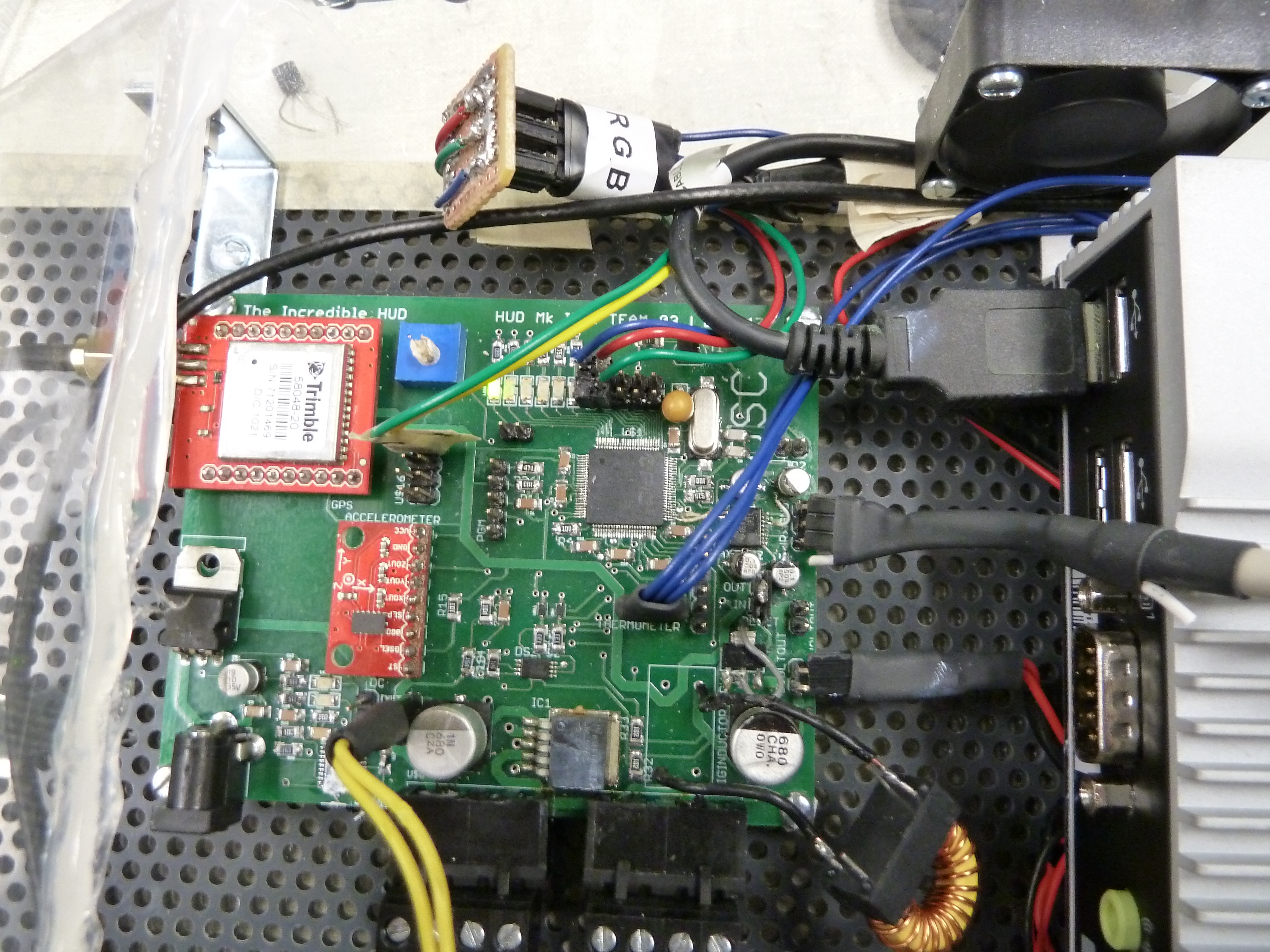

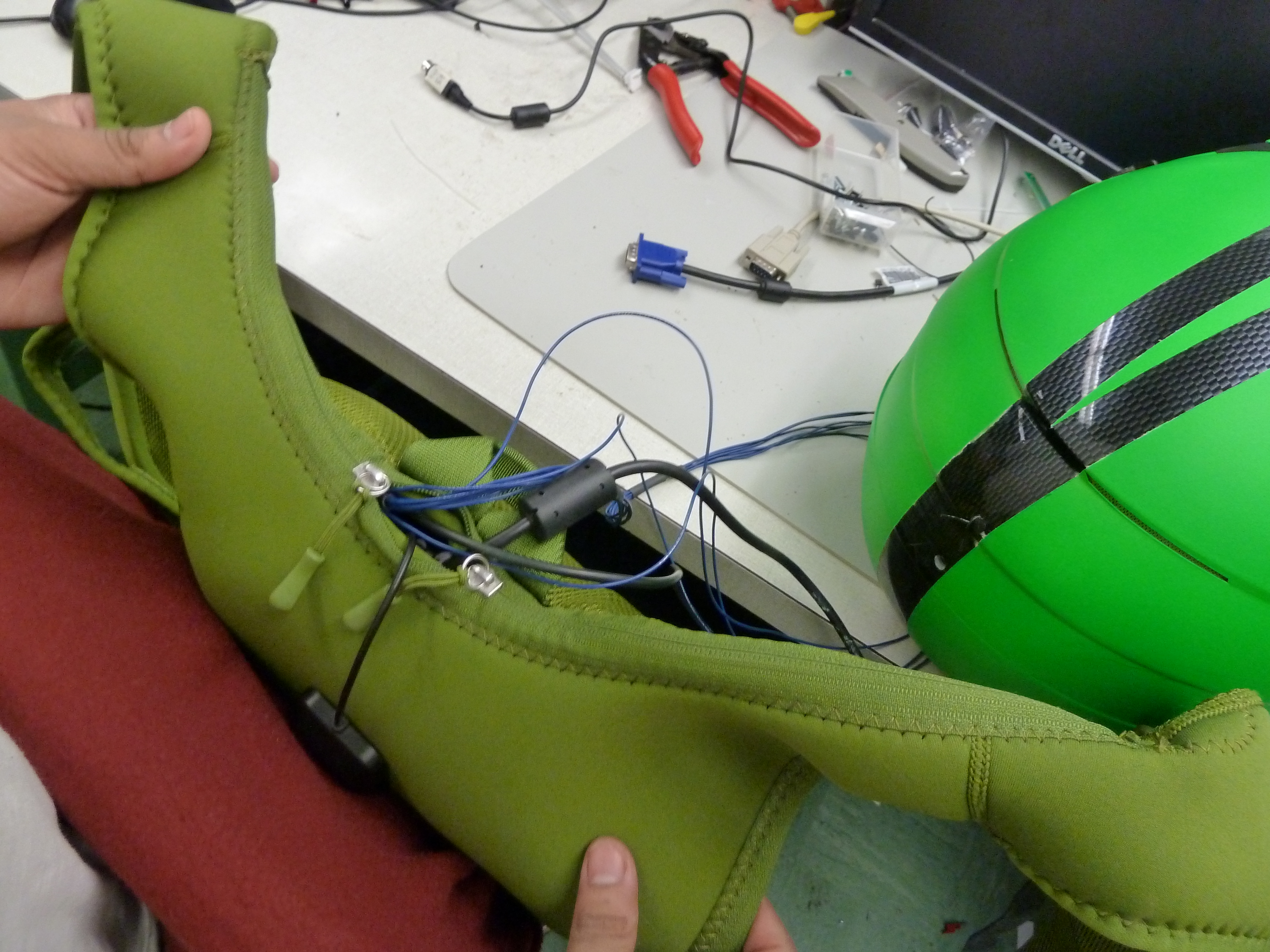
Awesome green spray paint was bought for the helmet.
WEEK 15 SUMMARY
Accomplishments: 1. Helped out Marcelo with the backpack unit. 2. Aditya finished painting the helmet.
Weekly Work Total: 10 hours
Project Work Total: 134.5 hours
Week 16
December 6, 2011 (5 hours) :
PSSCs are complete. We decided to take the helmet out for a swing around MSEE. Marcelo got some nice footage from inside the helmet when he was running up Northwestern. The GPS does take a little bit of time to lock in, but it works great afterwards. There were some minor bugs noted with the altitude and the time not displaying correctly. Here's a picture of the painted helmet and the path we walked around on google earth.
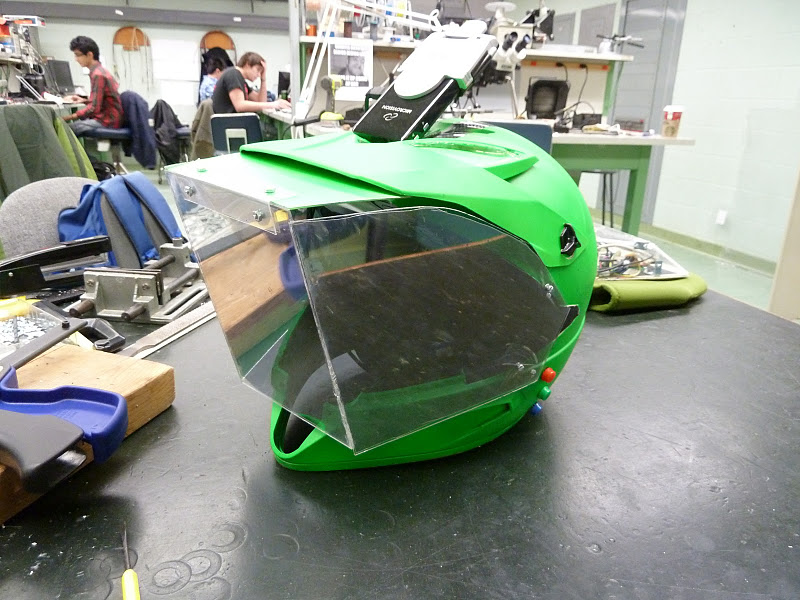

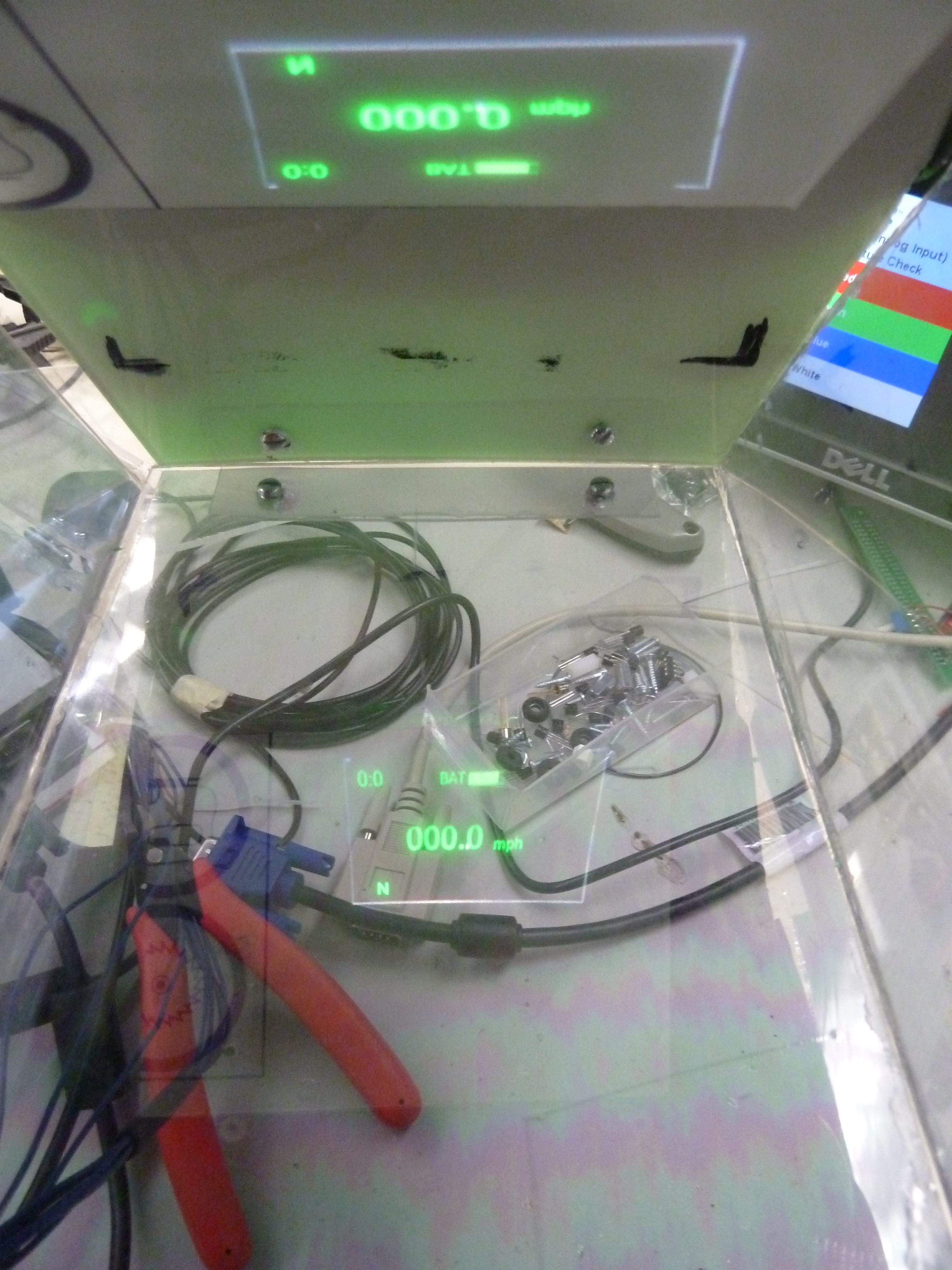
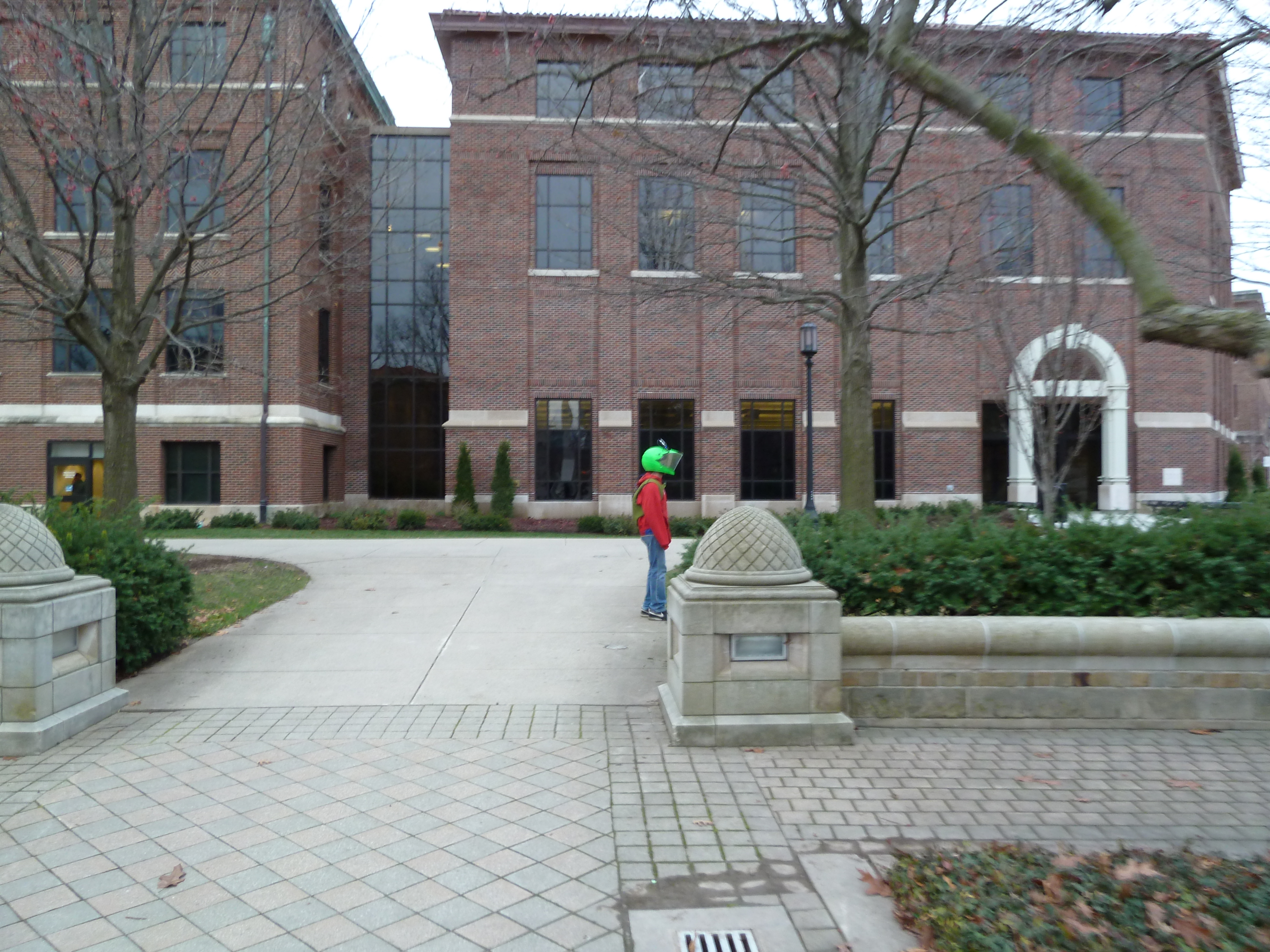

December 7th, 2011 (4 hours)
Spent a few minutes with Blaine fixing some final bugs with altitude and time displaying incorrectly. With all the PSSCs finally checked off, work on the documentation continued. The Atom boards from intel arrived for our Cornell Cup. Just hooked one up and turned one on, and linux was installed. Sweet.
December 9th, 2011 (0 hours)
Aditya put up video!
WEEK 16 SUMMARY
Accomplishments: 1. PSSCs checked off. 2. Documentation mostly done. 3. Demo video!
Weekly Work Total: 9 hours
Project Work Total: 133.5 hours
 We decided to talk to an optics professor on this.
We decided to talk to an optics professor on this.




















